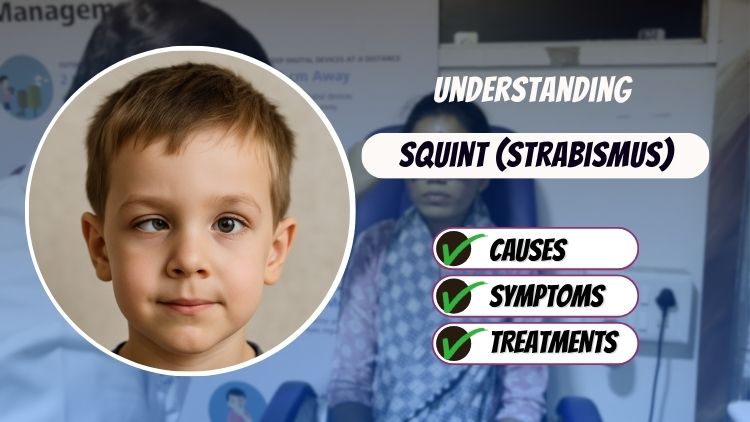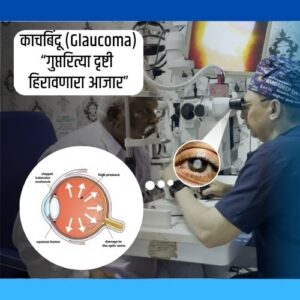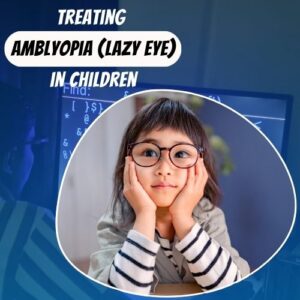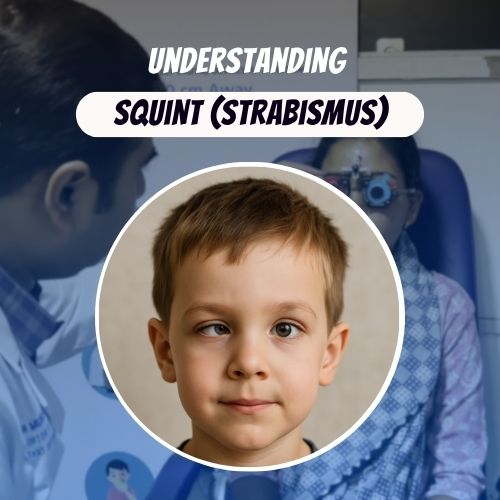Understanding Squint (Strabismus): Symptoms, Diagnosis, and Treatment Options

Introduction
Squint, medically known as strabismus, is a condition where both eyes do not align in the same direction. One eye may turn upward, downward, inward, or outward while the other eye is focused directly ahead. Particularly in children, squint in kids can impair both confidence and eyesight, as well as depth perception. To avoid long-term issues such as awkward social situations or lazy eye (amblyopia), early squint diagnosis and treatment are crucial. Squint is more common in youngsters, but several underlying factors can also cause squint in adults. If you notice symptoms of misaligned eyes, consulting an eye specialist for squint or visiting a paediatric ophthalmologist can ensure timely care and improved vision.
What Is Squint (Strabismus)?
When the eye muscles are unable to synchronize, strabismus results. One eye may sometimes or continuously stray in a different direction due to this lack of coordination. The direction of the eye turn determines the type of squint:
- Esotropia – inward turning of the eye
- Exotropia – outward turning of the eye
- Hypertropia – upward turning of the eye
- Hypotropia – downward turning of the eye
Squint can be constant (present all the time) or intermittent (occurs occasionally). A common misconception is that children will simply “grow out of” a squint. In reality, most cases require medical attention to avoid permanent vision problems and ensure proper visual development.
Symptoms of Squint
The most noticeable symptom is visible misalignment of the eyes. However, there are other signs to watch for:
- Double vision or blurred vision, more common in adults
- Eye strain or discomfort
- Poor depth perception, making tasks like catching a ball difficult
- Head tilting or turning to use the better eye
- Squinting or closing one eye, especially in bright light
- Difficulty focusing, which can affect school performance
In young children, these signs may be subtle, so regular eye check-ups are important.
Causes and Risk Factors
Squint may be congenital (present from birth) or acquired later in life. Common causes and risk factors include:
- Uncorrected refractive errors, especially farsightedness
- Muscle or nerve problems controlling eye movement
- Eye injuries or trauma
- Neurological conditions such as cerebral palsy or hydrocephalus
- Genetic predisposition, with squint often running in families
- Medical syndromes, like Down syndrome
Understanding the root cause is vital for choosing the most effective treatment.
How Squint Is Diagnosed
A comprehensive eye exam by a squint specialist or paediatric ophthalmologist is necessary to accurately diagnose the condition. Diagnostic tests may include:
- Visual acuity tests to assess the sharpness of vision in each eye
- Cover test and corneal light reflex test to evaluate eye alignment
- Retinal examination to rule out structural abnormalities
- Refraction tests to detect the need for corrective lenses
In certain cases, advanced imaging or a referral to a neurologist might be needed, particularly when a neurological issue is suspected.
Treatment Options for Squint
The type and extent of squint, the patient’s age, and the underlying reason all influence the course of treatment. Restoring eye alignment, enhancing binocular vision, and avoiding long-term issues like amblyopia (lazy eye) are the key objectives. These are the most popular choices:
- Prescription Glasses: The squint can be greatly reduced or eliminated by correcting refractive problems, particularly in farsighted children. Eye alignment may often be improved only by wearing glasses.
- Eye Patching: Patching the stronger eye in cases of amblyopia helps the weaker eye become stimulated more and improves its ability to see. With younger children, whose brains are more adaptable, this works especially effectively.
- Vision Therapy: Focus, sense of depth, and eye-hand coordination are all enhanced by an organised eye training program. Patients with post-operative residual misalignment, convergence insufficiency, or intermittent squint may benefit greatly from vision treatment.
➤ Click below to see how vision therapy helped one of our patients regain clear, comfortable vision.
Prism Lenses: Particularly for individuals with double vision, special lenses can be given to correct eye misalignment and bend light. They aid in visual field alignment and are a non-invasive option.
Medications: Some medications can be used to temporarily relax overactive eye muscles as part of a broader treatment plan.
Eye Muscle Surgery: During surgery, the muscles around the eye are repositioned to improve alignment. It is often performed as an outpatient procedure; however, in cases of severe or ongoing misalignment, it can be necessary. Although surgery aids in alignment, it generally works in conjunction with glasses or treatment to fully restore binocular vision.
➤ Click below to see how Squint Surgery helped one of our patients regain clear, comfortable vision.
Treatments are often staged or combined, and regular follow-ups are essential to monitor improvement and make adjustments as needed.
Importance of Early Intervention
Treating squint early—ideally before the age of 7—can prevent permanent vision loss and improve long-term outcomes. Here’s how early detection helps:
- Protects against amblyopia: In young children, the brain may begin to ignore input from the misaligned eye, leading to amblyopia, also known as lazy eye. Timely treatment can reverse this.
- Ensures normal visual development: Vision is a learned skill. Proper alignment allows both eyes to work together, improving depth perception and hand-eye coordination.
- Boosts confidence and self-esteem: Children with visible squints often feel self-conscious about their appearance. Restoring eye alignment can greatly improve their social interactions and mental well-being.
- Reduces need for complex treatments later: The earlier the intervention, the simpler the solution, avoiding the need for extensive therapy or multiple surgeries.
Myths vs. Facts About Squint
Let’s clear up some common myths:
- Myth: Children will outgrow squint naturally.
- Fact: Most cases require medical treatment to prevent long-term vision problems.
- Myth: Home remedies or “eye exercises from the internet” can cure squint.
- Fact: Only professionally guided therapies or surgery offer reliable correction.
- Myth: Squint is caused by evil spirits or curses.
- Fact: Squint is a medical condition with scientifically known causes and effective treatments.
Conclusion
Squint is not just a cosmetic concern; if left untreated, it can lead to vision loss, poor depth perception, and psychological distress. Fortunately, with early diagnosis, expert evaluation, and the right treatment—whether it’s glasses, eye patching, vision therapy, or squint surgery outcomes can be highly successful.
If you or your child shows signs of squint, don’t wait. Consult an eye specialist and explore your options.
➤ Watch patient success stories to see how early treatment changed their lives.
With the right care and guidance, individuals with squint can enjoy a clear, confident, and focused future.
More Posts

Everything You Should Know About Pediatric Eye Exams

काचबिंदू (Glaucoma): नियमित नेत्रतपासणी का आवश्यक आहे?







